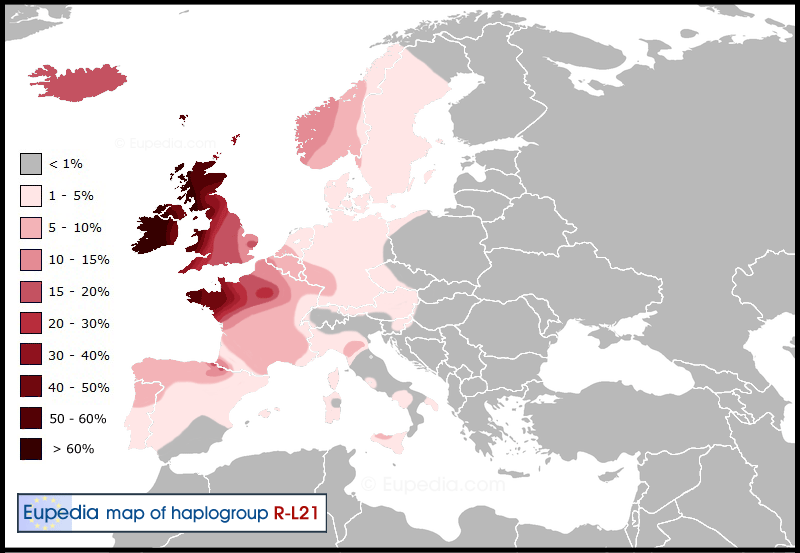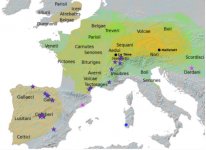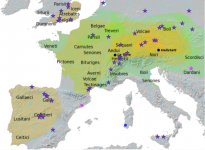celtiberian-II
Regular Member
- Messages
- 63
- Reaction score
- 24
- Points
- 8
- Location
- Seville
- Ethnic group
- 100% NW Castilian
- Y-DNA haplogroup
- J-L26
- mtDNA haplogroup
- H
Tibor Fehér: Celtic and Italic from the West – the Genetic Evidence, Academia Letters, July 2021.
Celtic studies in the last two decades lead by John T. Koch and Barry Cunliffe have questioned the validity of the long-time theory “Hallstatt Iron Age = proto-Celtic culture”, arguing for an early Celtic Atlantic Bronze Age in their “Celtic from the West” series. 1 The argument goes that Gündlingen type swords originated in the late Bronze Age Britain and Low Countries and have later spread from the West to East to spread further from the Halstatt Alpine Iron Age. The Celtic nature of Tartessian from pre-Iron Age South-Western Iberia also testifies the early Atlantic origin of proto-Celtic. Y-DNA (inherited only through the male line) and autosomal ancient DNA results increasingly support the “Celtic from the West”, going even further this paper argues for an “Italo-Celtic” from the North-West.
Recent archaeogenetic studies 2 proved that R1b-M269 males, today dominant lin- eage in Central and Western Europe originate from the Pontic-Caspian Steppes that is today’s Ukraine and Southern Russia. A pre-M269 but non-M73 male, i.e. leading from P297 towards M269 ancestor was found in Samara culture on the Volga River living around 5500 BC. It was also confirmed that the Kurgan-building Yamnaya steppe herders and their eastern offshoot Afanasievo culture (probably proto-Tocharian) belonged predominantly to Haplogroup R1b-Z2103.
Later studies clarified that late Proto-Indo-European (“Aryan proper”) language was most likely spoken in the Corded Ware Cultural (CWC) complex (2900-2350 BC). It shows significant Yamnaya-related Western Steppe Herder (WSH) autosomal ancestry, and has geographical subgroups fitting the spread of specific subfamilies. Proto-Indo-Iranians derive from Sintashta culture (2200-1800) coming from the eastern side of CWC Fatyanovo- Balanovo culture (2900-2200 BC), being mostly R1a-Z93 on the paternal line. Proto-Balto- Slavs are the candidate for descending from CWC Middle Dniepr culture (3200-2300 BC) being R1a-Z280 and moving north to replace the Mesolithic Narva culture. Battle Axe culture (2800-2300 BC) is the CWC branch in Scandinavia where R1a-Z284 and I1-M253 prevails, replacing Pitted Ware Mesolithic. Last but not least, Single Grave culture (2800-2200 BC) replaced TRB Neolithic in the North German Plain and Denmark, being ancestral to later Bell Beaker culture from 2500 BC (R1b-L11/P311).
What do you think?
Celtic studies in the last two decades lead by John T. Koch and Barry Cunliffe have questioned the validity of the long-time theory “Hallstatt Iron Age = proto-Celtic culture”, arguing for an early Celtic Atlantic Bronze Age in their “Celtic from the West” series. 1 The argument goes that Gündlingen type swords originated in the late Bronze Age Britain and Low Countries and have later spread from the West to East to spread further from the Halstatt Alpine Iron Age. The Celtic nature of Tartessian from pre-Iron Age South-Western Iberia also testifies the early Atlantic origin of proto-Celtic. Y-DNA (inherited only through the male line) and autosomal ancient DNA results increasingly support the “Celtic from the West”, going even further this paper argues for an “Italo-Celtic” from the North-West.
Recent archaeogenetic studies 2 proved that R1b-M269 males, today dominant lin- eage in Central and Western Europe originate from the Pontic-Caspian Steppes that is today’s Ukraine and Southern Russia. A pre-M269 but non-M73 male, i.e. leading from P297 towards M269 ancestor was found in Samara culture on the Volga River living around 5500 BC. It was also confirmed that the Kurgan-building Yamnaya steppe herders and their eastern offshoot Afanasievo culture (probably proto-Tocharian) belonged predominantly to Haplogroup R1b-Z2103.
Later studies clarified that late Proto-Indo-European (“Aryan proper”) language was most likely spoken in the Corded Ware Cultural (CWC) complex (2900-2350 BC). It shows significant Yamnaya-related Western Steppe Herder (WSH) autosomal ancestry, and has geographical subgroups fitting the spread of specific subfamilies. Proto-Indo-Iranians derive from Sintashta culture (2200-1800) coming from the eastern side of CWC Fatyanovo- Balanovo culture (2900-2200 BC), being mostly R1a-Z93 on the paternal line. Proto-Balto- Slavs are the candidate for descending from CWC Middle Dniepr culture (3200-2300 BC) being R1a-Z280 and moving north to replace the Mesolithic Narva culture. Battle Axe culture (2800-2300 BC) is the CWC branch in Scandinavia where R1a-Z284 and I1-M253 prevails, replacing Pitted Ware Mesolithic. Last but not least, Single Grave culture (2800-2200 BC) replaced TRB Neolithic in the North German Plain and Denmark, being ancestral to later Bell Beaker culture from 2500 BC (R1b-L11/P311).
What do you think?





